AirAsia Marketing Plan: Strategy, Analysis, and Recommendations
VerifiedAdded on 2022/11/14
|23
|5255
|437
Report
AI Summary
This report offers a thorough examination of AirAsia's marketing strategies within the context of the airline industry. It begins with an overview of the industry, its lifecycle, and AirAsia's organizational context, including its size, current markets, and financial position. A detailed situation analysis follows, incorporating SWOT and PESTEL analyses to assess internal strengths and weaknesses and external opportunities and threats. The report then delves into AirAsia's current marketing strategies, including marketing objectives, differentiation strategies, customer analysis, brand positioning, and the marketing mix. Market segmentation, targeting, and positioning are also examined. The report concludes with recommended strategies for future marketing development, referencing relevant academic literature. The report covers a wide range of topics including the airline industry, industry lifecycle, AirAsia's current market position, SWOT and PESTEL analysis, marketing strategies, segmentation, targeting, and positioning. It offers insights into the company's financial performance and provides recommendations for future marketing strategy development.
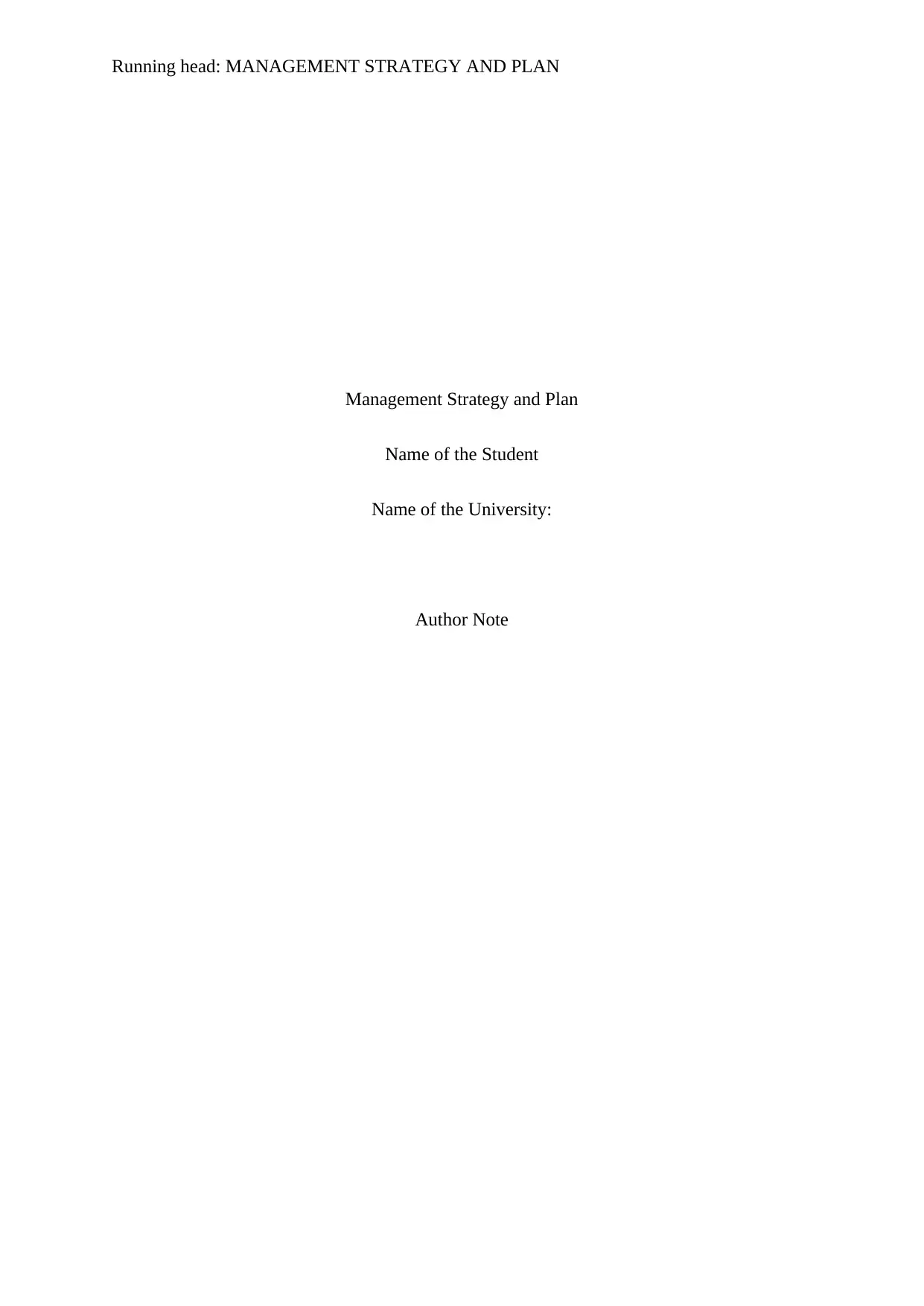
Running head: MANAGEMENT STRATEGY AND PLAN
Management Strategy and Plan
Name of the Student
Name of the University:
Author Note
Management Strategy and Plan
Name of the Student
Name of the University:
Author Note
Paraphrase This Document
Need a fresh take? Get an instant paraphrase of this document with our AI Paraphraser
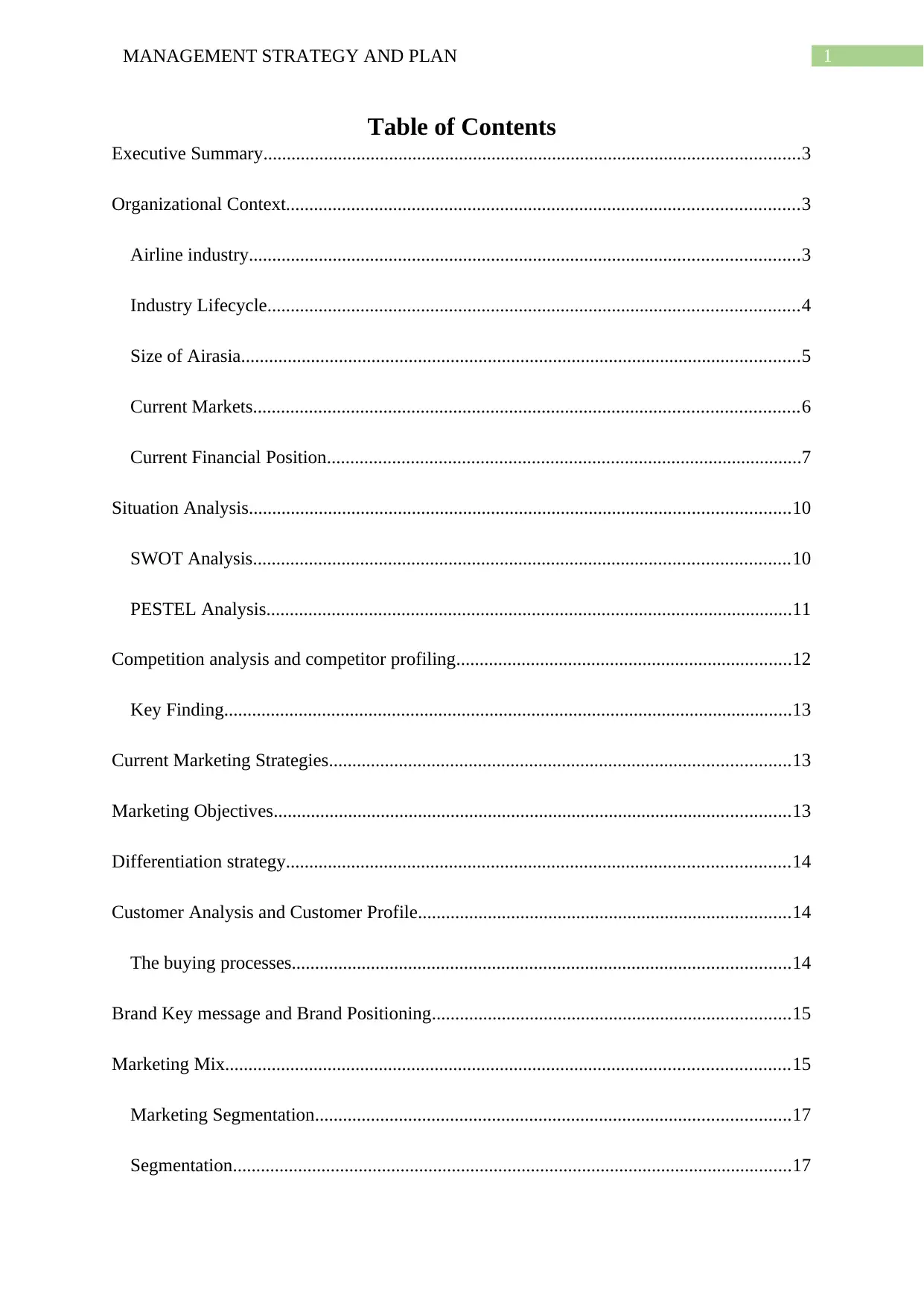
1MANAGEMENT STRATEGY AND PLAN
Table of Contents
Executive Summary...................................................................................................................3
Organizational Context..............................................................................................................3
Airline industry......................................................................................................................3
Industry Lifecycle..................................................................................................................4
Size of Airasia........................................................................................................................5
Current Markets.....................................................................................................................6
Current Financial Position......................................................................................................7
Situation Analysis....................................................................................................................10
SWOT Analysis...................................................................................................................10
PESTEL Analysis.................................................................................................................11
Competition analysis and competitor profiling........................................................................12
Key Finding..........................................................................................................................13
Current Marketing Strategies...................................................................................................13
Marketing Objectives...............................................................................................................13
Differentiation strategy............................................................................................................14
Customer Analysis and Customer Profile................................................................................14
The buying processes...........................................................................................................14
Brand Key message and Brand Positioning.............................................................................15
Marketing Mix.........................................................................................................................15
Marketing Segmentation......................................................................................................17
Segmentation........................................................................................................................17
Table of Contents
Executive Summary...................................................................................................................3
Organizational Context..............................................................................................................3
Airline industry......................................................................................................................3
Industry Lifecycle..................................................................................................................4
Size of Airasia........................................................................................................................5
Current Markets.....................................................................................................................6
Current Financial Position......................................................................................................7
Situation Analysis....................................................................................................................10
SWOT Analysis...................................................................................................................10
PESTEL Analysis.................................................................................................................11
Competition analysis and competitor profiling........................................................................12
Key Finding..........................................................................................................................13
Current Marketing Strategies...................................................................................................13
Marketing Objectives...............................................................................................................13
Differentiation strategy............................................................................................................14
Customer Analysis and Customer Profile................................................................................14
The buying processes...........................................................................................................14
Brand Key message and Brand Positioning.............................................................................15
Marketing Mix.........................................................................................................................15
Marketing Segmentation......................................................................................................17
Segmentation........................................................................................................................17
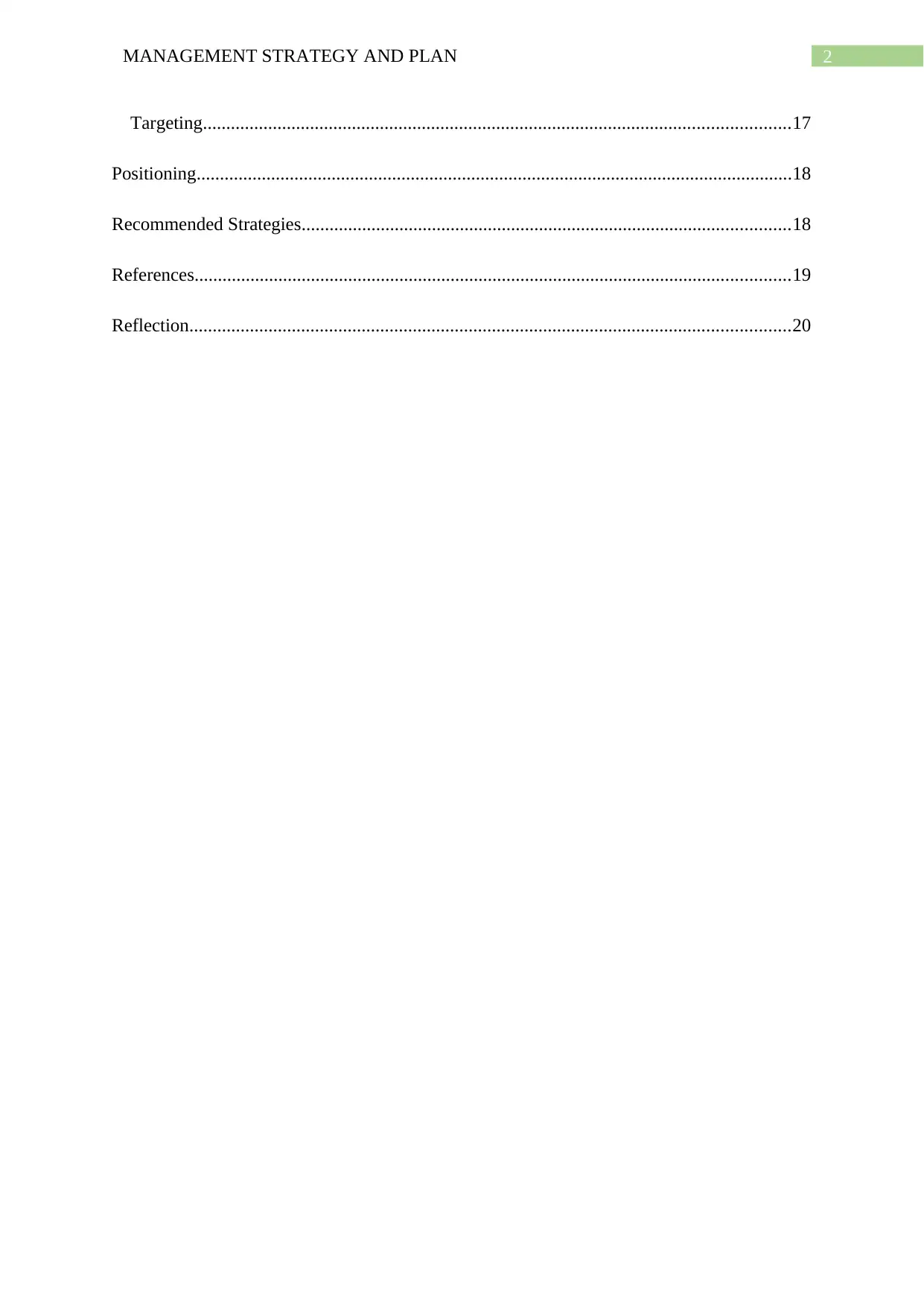
2MANAGEMENT STRATEGY AND PLAN
Targeting..............................................................................................................................17
Positioning................................................................................................................................18
Recommended Strategies.........................................................................................................18
References................................................................................................................................19
Reflection.................................................................................................................................20
Targeting..............................................................................................................................17
Positioning................................................................................................................................18
Recommended Strategies.........................................................................................................18
References................................................................................................................................19
Reflection.................................................................................................................................20
⊘ This is a preview!⊘
Do you want full access?
Subscribe today to unlock all pages.

Trusted by 1+ million students worldwide
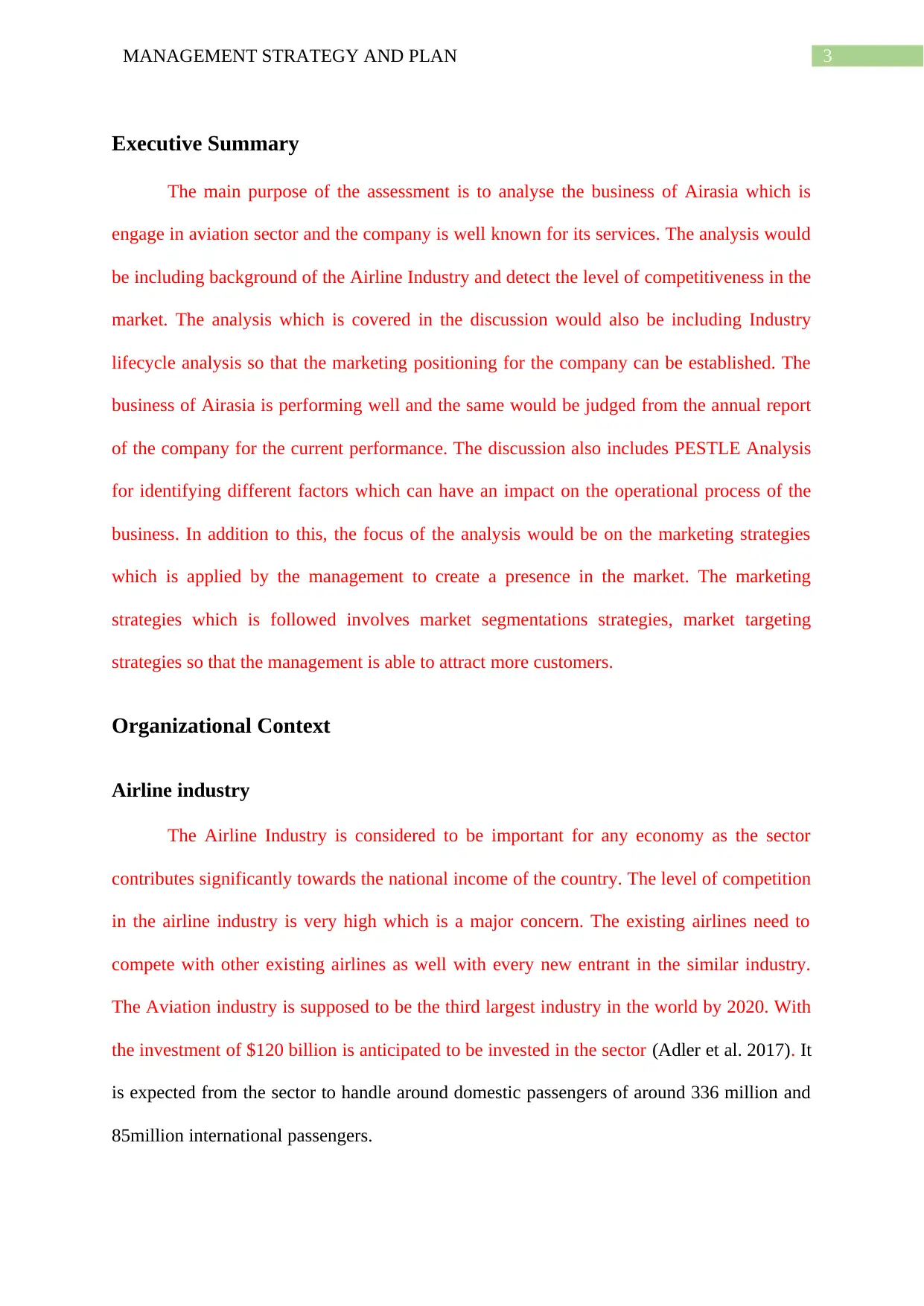
3MANAGEMENT STRATEGY AND PLAN
Executive Summary
The main purpose of the assessment is to analyse the business of Airasia which is
engage in aviation sector and the company is well known for its services. The analysis would
be including background of the Airline Industry and detect the level of competitiveness in the
market. The analysis which is covered in the discussion would also be including Industry
lifecycle analysis so that the marketing positioning for the company can be established. The
business of Airasia is performing well and the same would be judged from the annual report
of the company for the current performance. The discussion also includes PESTLE Analysis
for identifying different factors which can have an impact on the operational process of the
business. In addition to this, the focus of the analysis would be on the marketing strategies
which is applied by the management to create a presence in the market. The marketing
strategies which is followed involves market segmentations strategies, market targeting
strategies so that the management is able to attract more customers.
Organizational Context
Airline industry
The Airline Industry is considered to be important for any economy as the sector
contributes significantly towards the national income of the country. The level of competition
in the airline industry is very high which is a major concern. The existing airlines need to
compete with other existing airlines as well with every new entrant in the similar industry.
The Aviation industry is supposed to be the third largest industry in the world by 2020. With
the investment of $120 billion is anticipated to be invested in the sector (Adler et al. 2017). It
is expected from the sector to handle around domestic passengers of around 336 million and
85million international passengers.
Executive Summary
The main purpose of the assessment is to analyse the business of Airasia which is
engage in aviation sector and the company is well known for its services. The analysis would
be including background of the Airline Industry and detect the level of competitiveness in the
market. The analysis which is covered in the discussion would also be including Industry
lifecycle analysis so that the marketing positioning for the company can be established. The
business of Airasia is performing well and the same would be judged from the annual report
of the company for the current performance. The discussion also includes PESTLE Analysis
for identifying different factors which can have an impact on the operational process of the
business. In addition to this, the focus of the analysis would be on the marketing strategies
which is applied by the management to create a presence in the market. The marketing
strategies which is followed involves market segmentations strategies, market targeting
strategies so that the management is able to attract more customers.
Organizational Context
Airline industry
The Airline Industry is considered to be important for any economy as the sector
contributes significantly towards the national income of the country. The level of competition
in the airline industry is very high which is a major concern. The existing airlines need to
compete with other existing airlines as well with every new entrant in the similar industry.
The Aviation industry is supposed to be the third largest industry in the world by 2020. With
the investment of $120 billion is anticipated to be invested in the sector (Adler et al. 2017). It
is expected from the sector to handle around domestic passengers of around 336 million and
85million international passengers.
Paraphrase This Document
Need a fresh take? Get an instant paraphrase of this document with our AI Paraphraser
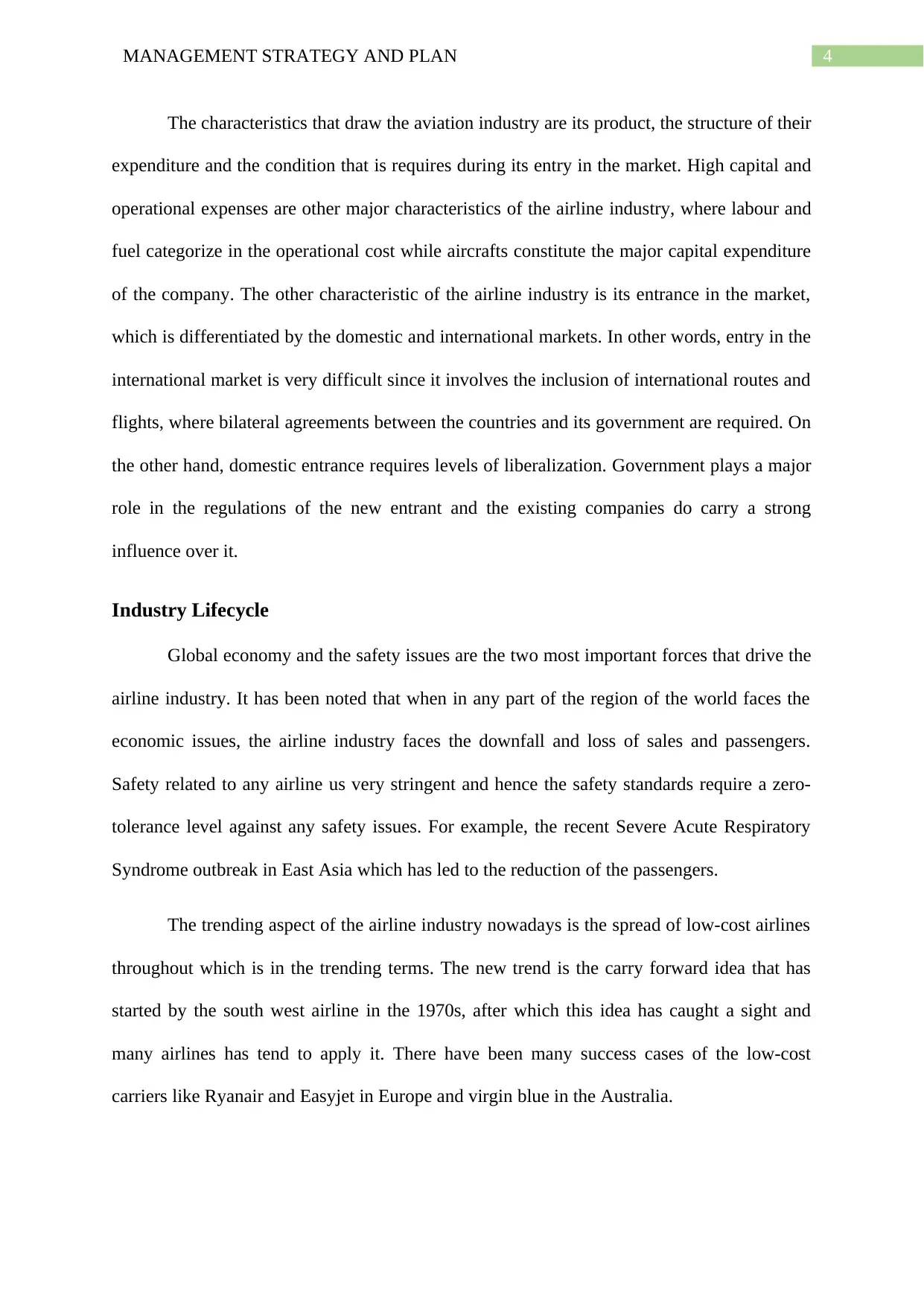
4MANAGEMENT STRATEGY AND PLAN
The characteristics that draw the aviation industry are its product, the structure of their
expenditure and the condition that is requires during its entry in the market. High capital and
operational expenses are other major characteristics of the airline industry, where labour and
fuel categorize in the operational cost while aircrafts constitute the major capital expenditure
of the company. The other characteristic of the airline industry is its entrance in the market,
which is differentiated by the domestic and international markets. In other words, entry in the
international market is very difficult since it involves the inclusion of international routes and
flights, where bilateral agreements between the countries and its government are required. On
the other hand, domestic entrance requires levels of liberalization. Government plays a major
role in the regulations of the new entrant and the existing companies do carry a strong
influence over it.
Industry Lifecycle
Global economy and the safety issues are the two most important forces that drive the
airline industry. It has been noted that when in any part of the region of the world faces the
economic issues, the airline industry faces the downfall and loss of sales and passengers.
Safety related to any airline us very stringent and hence the safety standards require a zero-
tolerance level against any safety issues. For example, the recent Severe Acute Respiratory
Syndrome outbreak in East Asia which has led to the reduction of the passengers.
The trending aspect of the airline industry nowadays is the spread of low-cost airlines
throughout which is in the trending terms. The new trend is the carry forward idea that has
started by the south west airline in the 1970s, after which this idea has caught a sight and
many airlines has tend to apply it. There have been many success cases of the low-cost
carriers like Ryanair and Easyjet in Europe and virgin blue in the Australia.
The characteristics that draw the aviation industry are its product, the structure of their
expenditure and the condition that is requires during its entry in the market. High capital and
operational expenses are other major characteristics of the airline industry, where labour and
fuel categorize in the operational cost while aircrafts constitute the major capital expenditure
of the company. The other characteristic of the airline industry is its entrance in the market,
which is differentiated by the domestic and international markets. In other words, entry in the
international market is very difficult since it involves the inclusion of international routes and
flights, where bilateral agreements between the countries and its government are required. On
the other hand, domestic entrance requires levels of liberalization. Government plays a major
role in the regulations of the new entrant and the existing companies do carry a strong
influence over it.
Industry Lifecycle
Global economy and the safety issues are the two most important forces that drive the
airline industry. It has been noted that when in any part of the region of the world faces the
economic issues, the airline industry faces the downfall and loss of sales and passengers.
Safety related to any airline us very stringent and hence the safety standards require a zero-
tolerance level against any safety issues. For example, the recent Severe Acute Respiratory
Syndrome outbreak in East Asia which has led to the reduction of the passengers.
The trending aspect of the airline industry nowadays is the spread of low-cost airlines
throughout which is in the trending terms. The new trend is the carry forward idea that has
started by the south west airline in the 1970s, after which this idea has caught a sight and
many airlines has tend to apply it. There have been many success cases of the low-cost
carriers like Ryanair and Easyjet in Europe and virgin blue in the Australia.
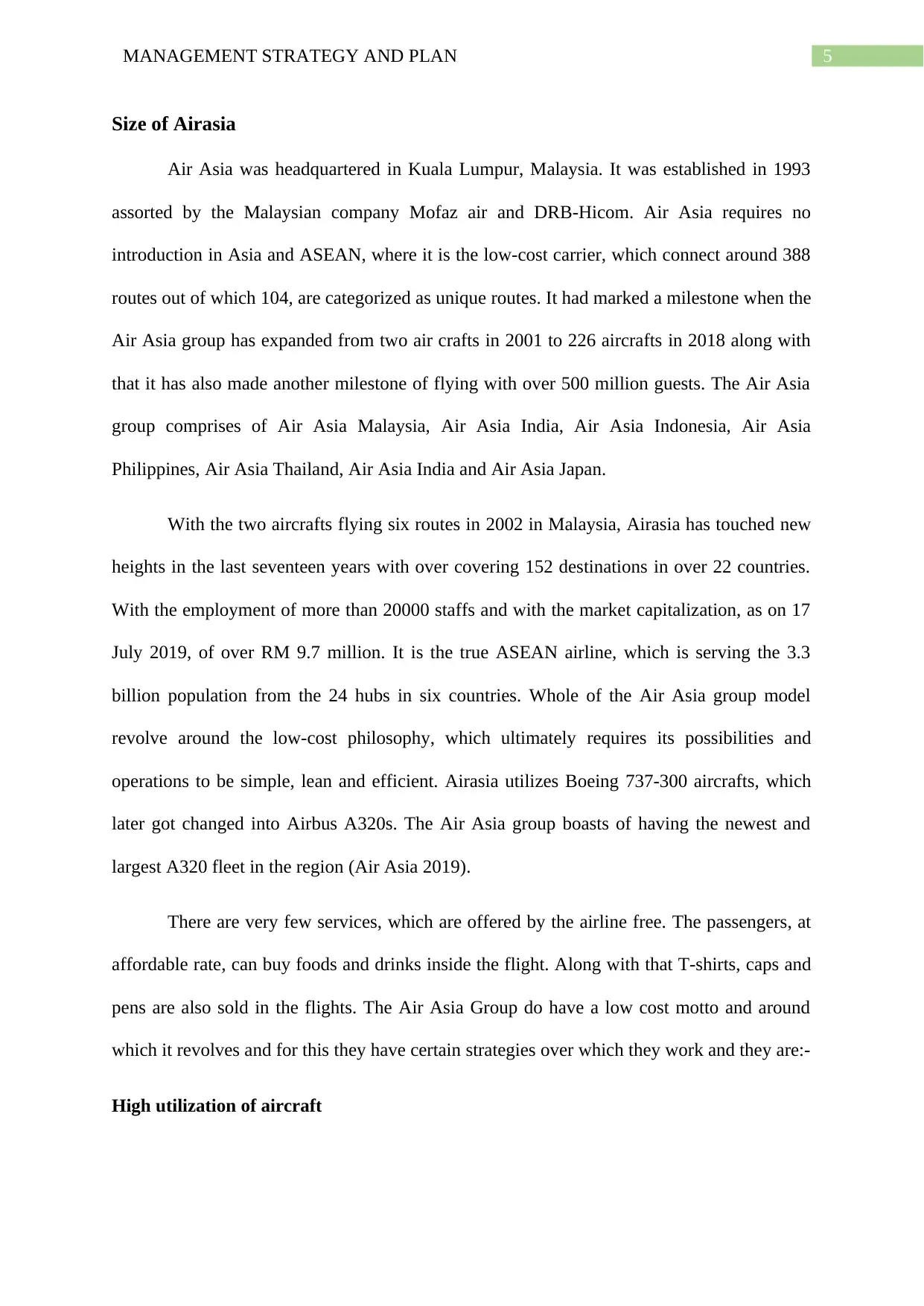
5MANAGEMENT STRATEGY AND PLAN
Size of Airasia
Air Asia was headquartered in Kuala Lumpur, Malaysia. It was established in 1993
assorted by the Malaysian company Mofaz air and DRB-Hicom. Air Asia requires no
introduction in Asia and ASEAN, where it is the low-cost carrier, which connect around 388
routes out of which 104, are categorized as unique routes. It had marked a milestone when the
Air Asia group has expanded from two air crafts in 2001 to 226 aircrafts in 2018 along with
that it has also made another milestone of flying with over 500 million guests. The Air Asia
group comprises of Air Asia Malaysia, Air Asia India, Air Asia Indonesia, Air Asia
Philippines, Air Asia Thailand, Air Asia India and Air Asia Japan.
With the two aircrafts flying six routes in 2002 in Malaysia, Airasia has touched new
heights in the last seventeen years with over covering 152 destinations in over 22 countries.
With the employment of more than 20000 staffs and with the market capitalization, as on 17
July 2019, of over RM 9.7 million. It is the true ASEAN airline, which is serving the 3.3
billion population from the 24 hubs in six countries. Whole of the Air Asia group model
revolve around the low-cost philosophy, which ultimately requires its possibilities and
operations to be simple, lean and efficient. Airasia utilizes Boeing 737-300 aircrafts, which
later got changed into Airbus A320s. The Air Asia group boasts of having the newest and
largest A320 fleet in the region (Air Asia 2019).
There are very few services, which are offered by the airline free. The passengers, at
affordable rate, can buy foods and drinks inside the flight. Along with that T-shirts, caps and
pens are also sold in the flights. The Air Asia Group do have a low cost motto and around
which it revolves and for this they have certain strategies over which they work and they are:-
High utilization of aircraft
Size of Airasia
Air Asia was headquartered in Kuala Lumpur, Malaysia. It was established in 1993
assorted by the Malaysian company Mofaz air and DRB-Hicom. Air Asia requires no
introduction in Asia and ASEAN, where it is the low-cost carrier, which connect around 388
routes out of which 104, are categorized as unique routes. It had marked a milestone when the
Air Asia group has expanded from two air crafts in 2001 to 226 aircrafts in 2018 along with
that it has also made another milestone of flying with over 500 million guests. The Air Asia
group comprises of Air Asia Malaysia, Air Asia India, Air Asia Indonesia, Air Asia
Philippines, Air Asia Thailand, Air Asia India and Air Asia Japan.
With the two aircrafts flying six routes in 2002 in Malaysia, Airasia has touched new
heights in the last seventeen years with over covering 152 destinations in over 22 countries.
With the employment of more than 20000 staffs and with the market capitalization, as on 17
July 2019, of over RM 9.7 million. It is the true ASEAN airline, which is serving the 3.3
billion population from the 24 hubs in six countries. Whole of the Air Asia group model
revolve around the low-cost philosophy, which ultimately requires its possibilities and
operations to be simple, lean and efficient. Airasia utilizes Boeing 737-300 aircrafts, which
later got changed into Airbus A320s. The Air Asia group boasts of having the newest and
largest A320 fleet in the region (Air Asia 2019).
There are very few services, which are offered by the airline free. The passengers, at
affordable rate, can buy foods and drinks inside the flight. Along with that T-shirts, caps and
pens are also sold in the flights. The Air Asia Group do have a low cost motto and around
which it revolves and for this they have certain strategies over which they work and they are:-
High utilization of aircraft
⊘ This is a preview!⊘
Do you want full access?
Subscribe today to unlock all pages.

Trusted by 1+ million students worldwide
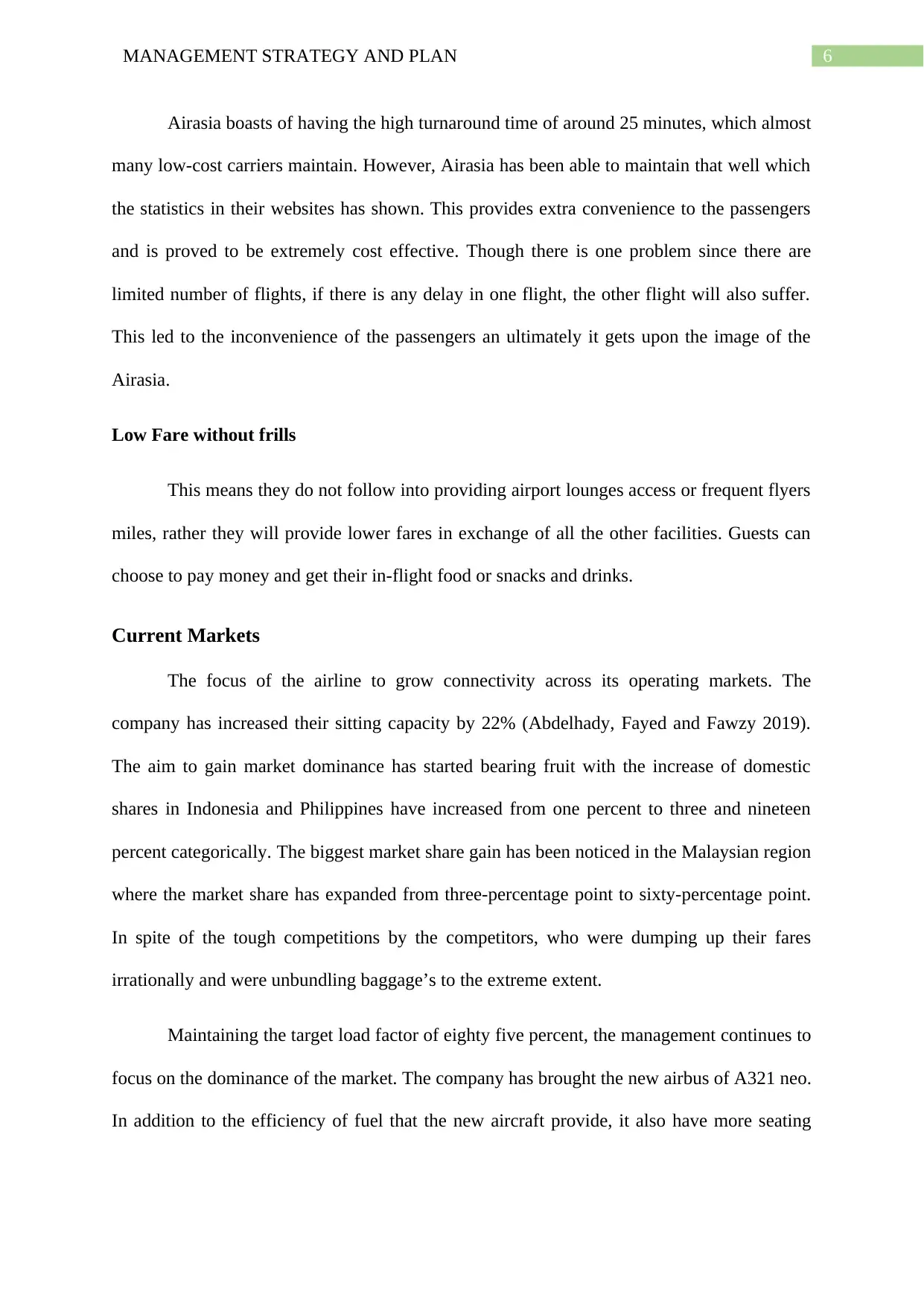
6MANAGEMENT STRATEGY AND PLAN
Airasia boasts of having the high turnaround time of around 25 minutes, which almost
many low-cost carriers maintain. However, Airasia has been able to maintain that well which
the statistics in their websites has shown. This provides extra convenience to the passengers
and is proved to be extremely cost effective. Though there is one problem since there are
limited number of flights, if there is any delay in one flight, the other flight will also suffer.
This led to the inconvenience of the passengers an ultimately it gets upon the image of the
Airasia.
Low Fare without frills
This means they do not follow into providing airport lounges access or frequent flyers
miles, rather they will provide lower fares in exchange of all the other facilities. Guests can
choose to pay money and get their in-flight food or snacks and drinks.
Current Markets
The focus of the airline to grow connectivity across its operating markets. The
company has increased their sitting capacity by 22% (Abdelhady, Fayed and Fawzy 2019).
The aim to gain market dominance has started bearing fruit with the increase of domestic
shares in Indonesia and Philippines have increased from one percent to three and nineteen
percent categorically. The biggest market share gain has been noticed in the Malaysian region
where the market share has expanded from three-percentage point to sixty-percentage point.
In spite of the tough competitions by the competitors, who were dumping up their fares
irrationally and were unbundling baggage’s to the extreme extent.
Maintaining the target load factor of eighty five percent, the management continues to
focus on the dominance of the market. The company has brought the new airbus of A321 neo.
In addition to the efficiency of fuel that the new aircraft provide, it also have more seating
Airasia boasts of having the high turnaround time of around 25 minutes, which almost
many low-cost carriers maintain. However, Airasia has been able to maintain that well which
the statistics in their websites has shown. This provides extra convenience to the passengers
and is proved to be extremely cost effective. Though there is one problem since there are
limited number of flights, if there is any delay in one flight, the other flight will also suffer.
This led to the inconvenience of the passengers an ultimately it gets upon the image of the
Airasia.
Low Fare without frills
This means they do not follow into providing airport lounges access or frequent flyers
miles, rather they will provide lower fares in exchange of all the other facilities. Guests can
choose to pay money and get their in-flight food or snacks and drinks.
Current Markets
The focus of the airline to grow connectivity across its operating markets. The
company has increased their sitting capacity by 22% (Abdelhady, Fayed and Fawzy 2019).
The aim to gain market dominance has started bearing fruit with the increase of domestic
shares in Indonesia and Philippines have increased from one percent to three and nineteen
percent categorically. The biggest market share gain has been noticed in the Malaysian region
where the market share has expanded from three-percentage point to sixty-percentage point.
In spite of the tough competitions by the competitors, who were dumping up their fares
irrationally and were unbundling baggage’s to the extreme extent.
Maintaining the target load factor of eighty five percent, the management continues to
focus on the dominance of the market. The company has brought the new airbus of A321 neo.
In addition to the efficiency of fuel that the new aircraft provide, it also have more seating
Paraphrase This Document
Need a fresh take? Get an instant paraphrase of this document with our AI Paraphraser
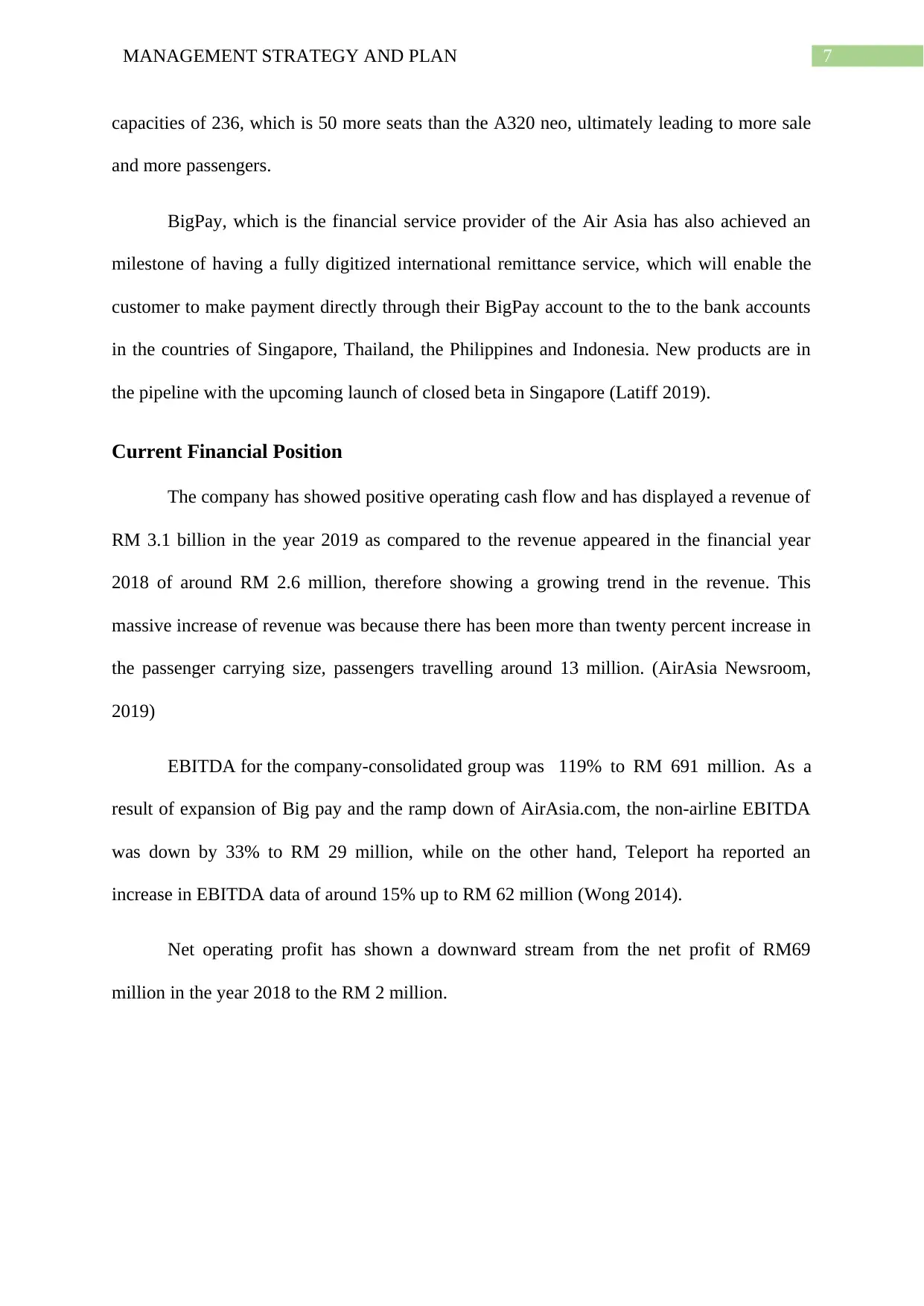
7MANAGEMENT STRATEGY AND PLAN
capacities of 236, which is 50 more seats than the A320 neo, ultimately leading to more sale
and more passengers.
BigPay, which is the financial service provider of the Air Asia has also achieved an
milestone of having a fully digitized international remittance service, which will enable the
customer to make payment directly through their BigPay account to the to the bank accounts
in the countries of Singapore, Thailand, the Philippines and Indonesia. New products are in
the pipeline with the upcoming launch of closed beta in Singapore (Latiff 2019).
Current Financial Position
The company has showed positive operating cash flow and has displayed a revenue of
RM 3.1 billion in the year 2019 as compared to the revenue appeared in the financial year
2018 of around RM 2.6 million, therefore showing a growing trend in the revenue. This
massive increase of revenue was because there has been more than twenty percent increase in
the passenger carrying size, passengers travelling around 13 million. (AirAsia Newsroom,
2019)
EBITDA for the company-consolidated group was 119% to RM 691 million. As a
result of expansion of Big pay and the ramp down of AirAsia.com, the non-airline EBITDA
was down by 33% to RM 29 million, while on the other hand, Teleport ha reported an
increase in EBITDA data of around 15% up to RM 62 million (Wong 2014).
Net operating profit has shown a downward stream from the net profit of RM69
million in the year 2018 to the RM 2 million.
capacities of 236, which is 50 more seats than the A320 neo, ultimately leading to more sale
and more passengers.
BigPay, which is the financial service provider of the Air Asia has also achieved an
milestone of having a fully digitized international remittance service, which will enable the
customer to make payment directly through their BigPay account to the to the bank accounts
in the countries of Singapore, Thailand, the Philippines and Indonesia. New products are in
the pipeline with the upcoming launch of closed beta in Singapore (Latiff 2019).
Current Financial Position
The company has showed positive operating cash flow and has displayed a revenue of
RM 3.1 billion in the year 2019 as compared to the revenue appeared in the financial year
2018 of around RM 2.6 million, therefore showing a growing trend in the revenue. This
massive increase of revenue was because there has been more than twenty percent increase in
the passenger carrying size, passengers travelling around 13 million. (AirAsia Newsroom,
2019)
EBITDA for the company-consolidated group was 119% to RM 691 million. As a
result of expansion of Big pay and the ramp down of AirAsia.com, the non-airline EBITDA
was down by 33% to RM 29 million, while on the other hand, Teleport ha reported an
increase in EBITDA data of around 15% up to RM 62 million (Wong 2014).
Net operating profit has shown a downward stream from the net profit of RM69
million in the year 2018 to the RM 2 million.
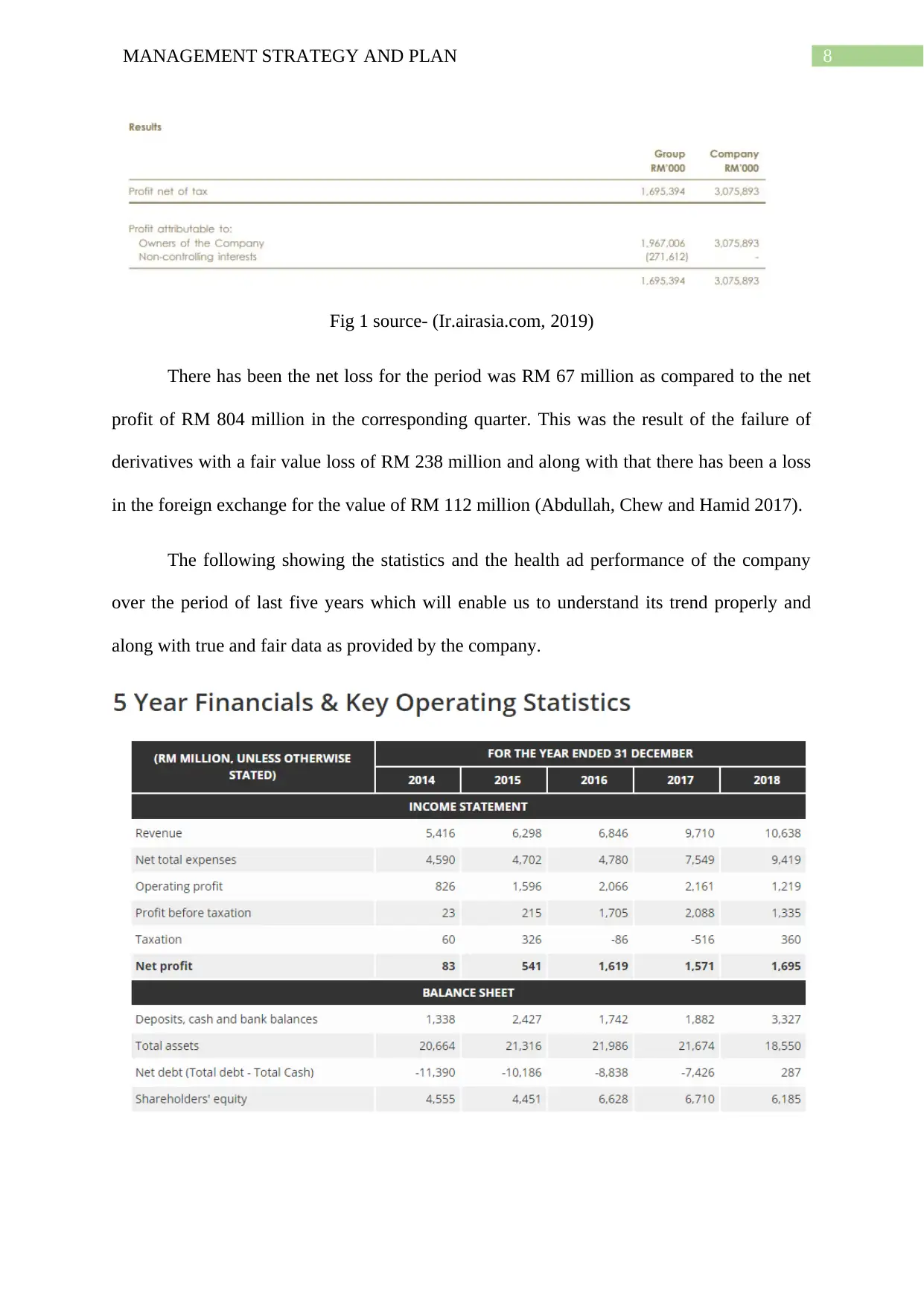
8MANAGEMENT STRATEGY AND PLAN
Fig 1 source- (Ir.airasia.com, 2019)
There has been the net loss for the period was RM 67 million as compared to the net
profit of RM 804 million in the corresponding quarter. This was the result of the failure of
derivatives with a fair value loss of RM 238 million and along with that there has been a loss
in the foreign exchange for the value of RM 112 million (Abdullah, Chew and Hamid 2017).
The following showing the statistics and the health ad performance of the company
over the period of last five years which will enable us to understand its trend properly and
along with true and fair data as provided by the company.
Fig 1 source- (Ir.airasia.com, 2019)
There has been the net loss for the period was RM 67 million as compared to the net
profit of RM 804 million in the corresponding quarter. This was the result of the failure of
derivatives with a fair value loss of RM 238 million and along with that there has been a loss
in the foreign exchange for the value of RM 112 million (Abdullah, Chew and Hamid 2017).
The following showing the statistics and the health ad performance of the company
over the period of last five years which will enable us to understand its trend properly and
along with true and fair data as provided by the company.
⊘ This is a preview!⊘
Do you want full access?
Subscribe today to unlock all pages.

Trusted by 1+ million students worldwide
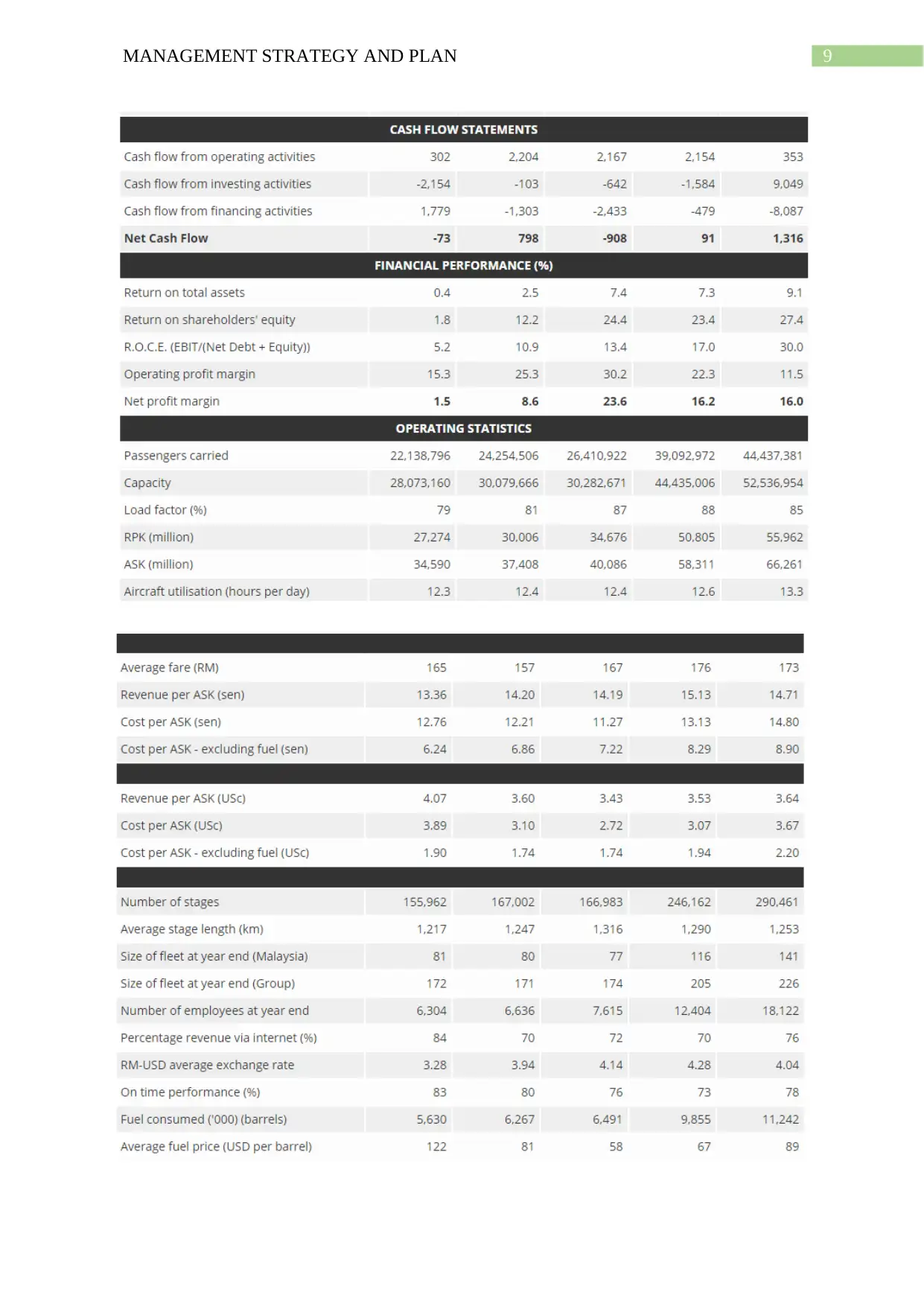
9MANAGEMENT STRATEGY AND PLAN
Paraphrase This Document
Need a fresh take? Get an instant paraphrase of this document with our AI Paraphraser
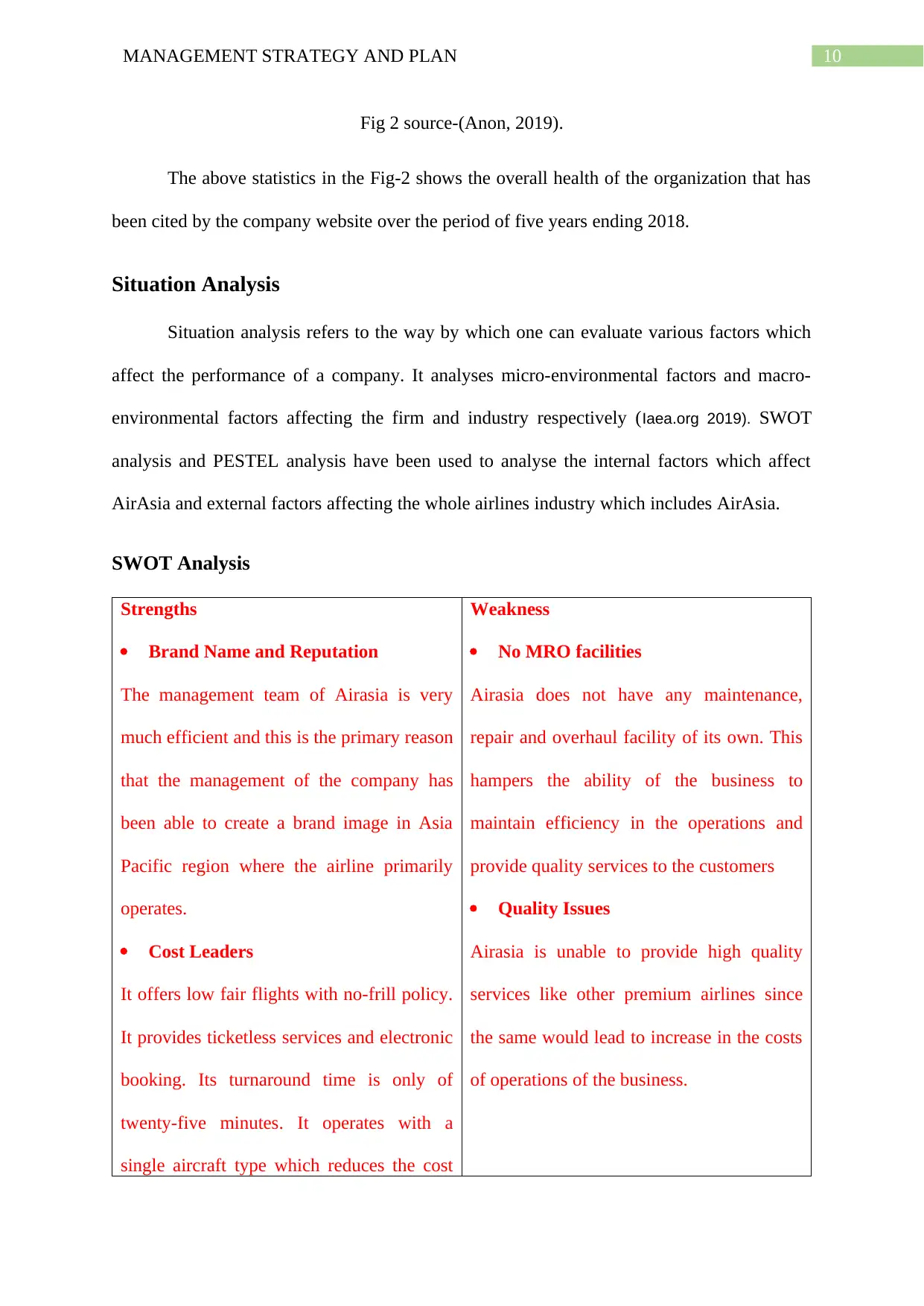
10MANAGEMENT STRATEGY AND PLAN
Fig 2 source-(Anon, 2019).
The above statistics in the Fig-2 shows the overall health of the organization that has
been cited by the company website over the period of five years ending 2018.
Situation Analysis
Situation analysis refers to the way by which one can evaluate various factors which
affect the performance of a company. It analyses micro-environmental factors and macro-
environmental factors affecting the firm and industry respectively (Iaea.org 2019). SWOT
analysis and PESTEL analysis have been used to analyse the internal factors which affect
AirAsia and external factors affecting the whole airlines industry which includes AirAsia.
SWOT Analysis
Strengths
Brand Name and Reputation
The management team of Airasia is very
much efficient and this is the primary reason
that the management of the company has
been able to create a brand image in Asia
Pacific region where the airline primarily
operates.
Cost Leaders
It offers low fair flights with no-frill policy.
It provides ticketless services and electronic
booking. Its turnaround time is only of
twenty-five minutes. It operates with a
single aircraft type which reduces the cost
Weakness
No MRO facilities
Airasia does not have any maintenance,
repair and overhaul facility of its own. This
hampers the ability of the business to
maintain efficiency in the operations and
provide quality services to the customers
Quality Issues
Airasia is unable to provide high quality
services like other premium airlines since
the same would lead to increase in the costs
of operations of the business.
Fig 2 source-(Anon, 2019).
The above statistics in the Fig-2 shows the overall health of the organization that has
been cited by the company website over the period of five years ending 2018.
Situation Analysis
Situation analysis refers to the way by which one can evaluate various factors which
affect the performance of a company. It analyses micro-environmental factors and macro-
environmental factors affecting the firm and industry respectively (Iaea.org 2019). SWOT
analysis and PESTEL analysis have been used to analyse the internal factors which affect
AirAsia and external factors affecting the whole airlines industry which includes AirAsia.
SWOT Analysis
Strengths
Brand Name and Reputation
The management team of Airasia is very
much efficient and this is the primary reason
that the management of the company has
been able to create a brand image in Asia
Pacific region where the airline primarily
operates.
Cost Leaders
It offers low fair flights with no-frill policy.
It provides ticketless services and electronic
booking. Its turnaround time is only of
twenty-five minutes. It operates with a
single aircraft type which reduces the cost
Weakness
No MRO facilities
Airasia does not have any maintenance,
repair and overhaul facility of its own. This
hampers the ability of the business to
maintain efficiency in the operations and
provide quality services to the customers
Quality Issues
Airasia is unable to provide high quality
services like other premium airlines since
the same would lead to increase in the costs
of operations of the business.
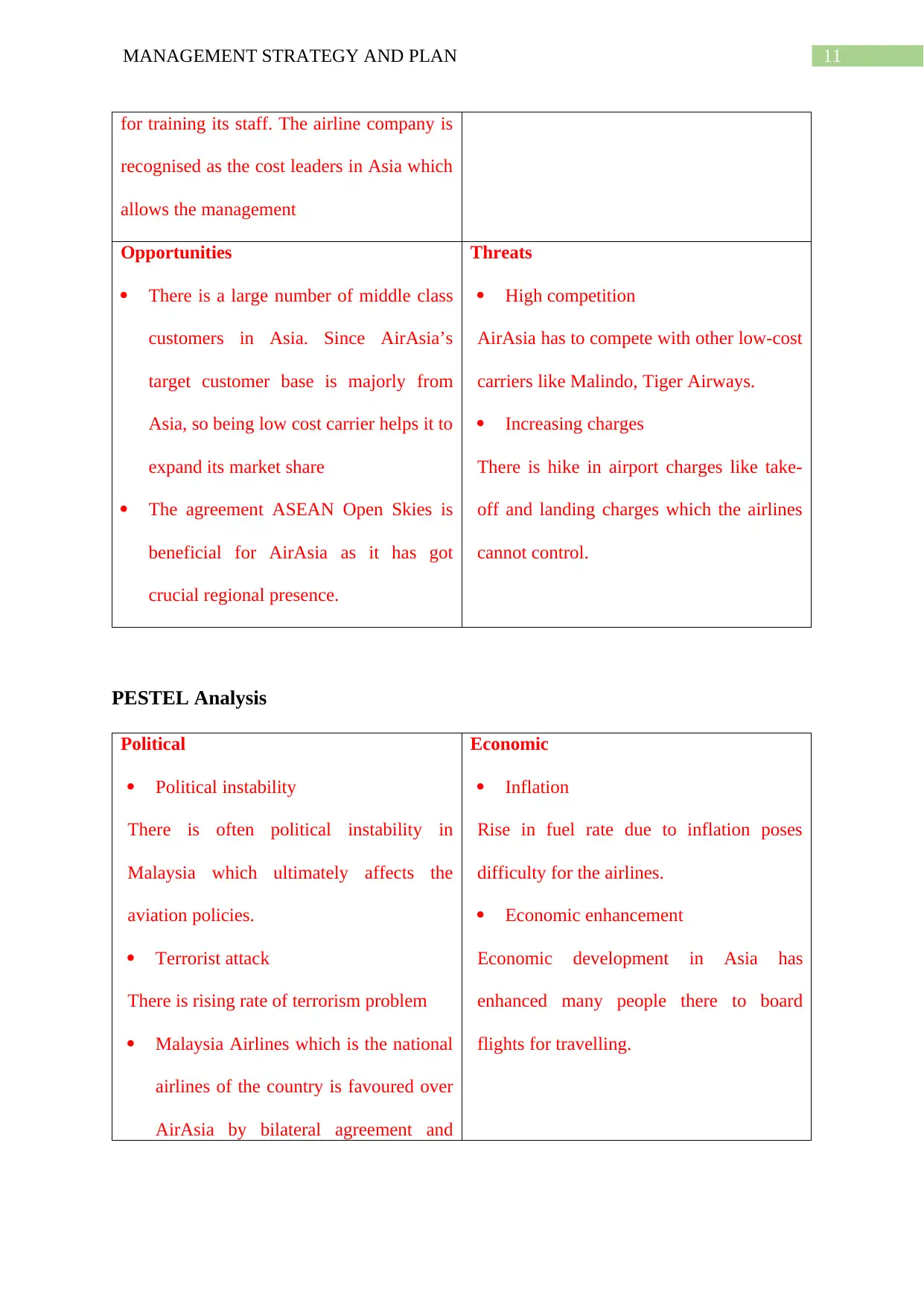
11MANAGEMENT STRATEGY AND PLAN
for training its staff. The airline company is
recognised as the cost leaders in Asia which
allows the management
Opportunities
There is a large number of middle class
customers in Asia. Since AirAsia’s
target customer base is majorly from
Asia, so being low cost carrier helps it to
expand its market share
The agreement ASEAN Open Skies is
beneficial for AirAsia as it has got
crucial regional presence.
Threats
High competition
AirAsia has to compete with other low-cost
carriers like Malindo, Tiger Airways.
Increasing charges
There is hike in airport charges like take-
off and landing charges which the airlines
cannot control.
PESTEL Analysis
Political
Political instability
There is often political instability in
Malaysia which ultimately affects the
aviation policies.
Terrorist attack
There is rising rate of terrorism problem
Malaysia Airlines which is the national
airlines of the country is favoured over
AirAsia by bilateral agreement and
Economic
Inflation
Rise in fuel rate due to inflation poses
difficulty for the airlines.
Economic enhancement
Economic development in Asia has
enhanced many people there to board
flights for travelling.
for training its staff. The airline company is
recognised as the cost leaders in Asia which
allows the management
Opportunities
There is a large number of middle class
customers in Asia. Since AirAsia’s
target customer base is majorly from
Asia, so being low cost carrier helps it to
expand its market share
The agreement ASEAN Open Skies is
beneficial for AirAsia as it has got
crucial regional presence.
Threats
High competition
AirAsia has to compete with other low-cost
carriers like Malindo, Tiger Airways.
Increasing charges
There is hike in airport charges like take-
off and landing charges which the airlines
cannot control.
PESTEL Analysis
Political
Political instability
There is often political instability in
Malaysia which ultimately affects the
aviation policies.
Terrorist attack
There is rising rate of terrorism problem
Malaysia Airlines which is the national
airlines of the country is favoured over
AirAsia by bilateral agreement and
Economic
Inflation
Rise in fuel rate due to inflation poses
difficulty for the airlines.
Economic enhancement
Economic development in Asia has
enhanced many people there to board
flights for travelling.
⊘ This is a preview!⊘
Do you want full access?
Subscribe today to unlock all pages.

Trusted by 1+ million students worldwide
1 out of 23
Related Documents
Your All-in-One AI-Powered Toolkit for Academic Success.
+13062052269
info@desklib.com
Available 24*7 on WhatsApp / Email
![[object Object]](/_next/static/media/star-bottom.7253800d.svg)
Unlock your academic potential
Copyright © 2020–2025 A2Z Services. All Rights Reserved. Developed and managed by ZUCOL.





